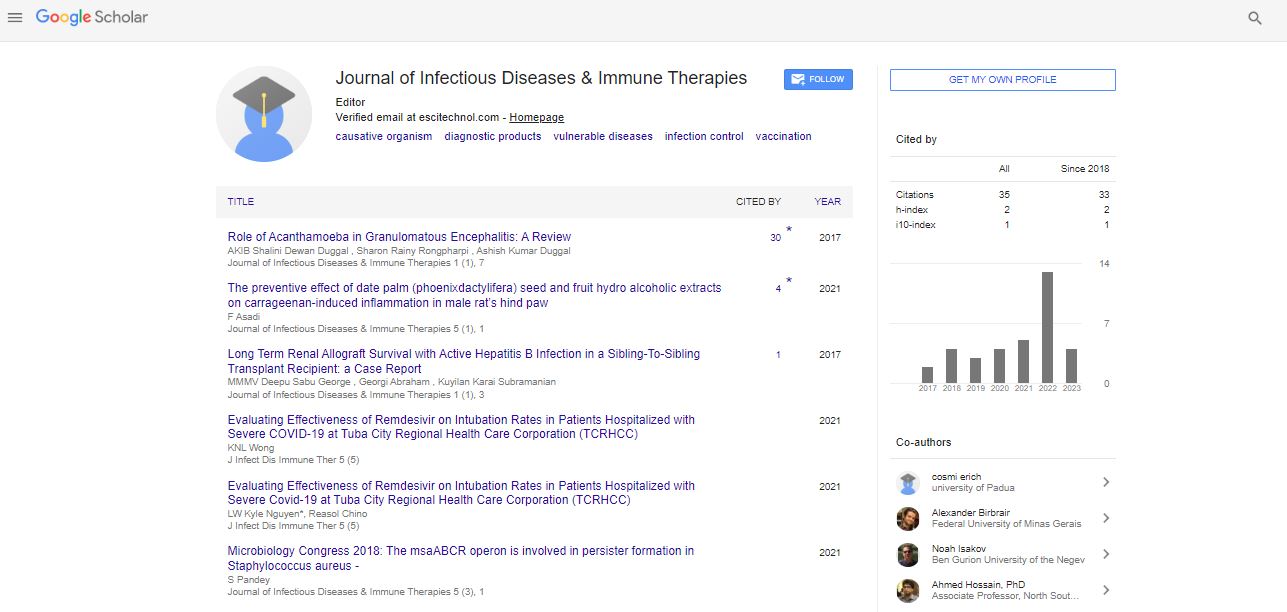Editorial, J Infect Dis Immune Ther Vol: 5 Issue: 6
A Brief Note on Immune Systems
Ahupathi Ballabh Narayana*
Department of Pulmonology, Kathmandu Medical College Teaching Hospital, Nepal
*Corresponding Author : Ahupathi Ballabh Narayana
Department of Pulmonology,Kathmandu Medical College Teaching Hospital, Nepal, E-mail: narayanaballabh-ne-@nic.in
Received: November 01, 2021; Accepted: November 15, 2021; Published: November 22, 2021
Citation: Narayana AB (2021) A Brief Note on Immune Syst em s. J Infec t Dis Immune Ther 5: 6.
Description
An organism's immune system is a web of biological processes that defends it from disease. It can identify and respond to a wide range of pathogens, including viruses, parasitic worms, cancer cells, and foreign objects like wood splinters, while separating them from the organisms own healthy tissue. The immune system is divided into two major subsystems in many species. The innate immune system responds to a wide range of events and stimuli with a pre-programmed reaction. By learning to recognised substances it has seen before, the adaptive immune system may respond to each stimulus in a unique way. Both rely on molecules and cells to carry out their tasks.
Immune systems are found in nearly all living things. Bacteria have a basic immune system that protects them from virus infections in the form of enzymes. Other basic immunological systems emerged in ancient plants and animals and are still in use today.
Phagocytosis, antimicrobial peptides known as defensins, and the complement system are examples of these systems. Humans and other jawed vertebrates have much more advanced defence mechanisms, including the ability to adapt to better recognised diseases. Adaptive (or acquired) immunity establishes an immunological memory, resulting in a stronger response to the pathogen in repeated encounters. Vaccination is based on this acquired immunity process.
Autoimmune illnesses, inflammatory diseases, and cancer can all be caused by immune system dysfunction. Immunodeficiency is a condition in which the immune system is less active than it should be, resulting in recurrent and potentially fatal infections. Immunodeficiency in humans can be caused by a hereditary disease like severe combined immunodeficiency, acquired disorders like HIV/ AIDS, or the use of immunosuppressive drugs. Autoimmunity is caused by an overactive immune system that attacks healthy tissues as though they were alien invaders. Hashimoto's thyroiditis, rheumatoid arthritis, type 1 diabetes, and systemic lupus erythematosus are all examples of autoimmune disorders. Immunology is the study of the immune system in its whole.
The immune system defends its host from infection with a series of tiered defences that become more precise as time goes on. Pathogens such as bacteria and viruses are prevented from entering the organism by physical barriers. When a pathogen gets past these barriers, the innate immune system responds with a broad, non-specific response. All animals have built in immune systems.
In the event that pathogens avoid the innate reaction, vertebrates have a second line of defence: the adaptive immune system, which is activated by the innate response. During an infection, the immune system changes its response to better pathogen detection. After the pathogen has been destroyed, this increased reaction is stored as an immunological memory, allowing the adaptive immune system to launch faster and stronger responses the next time the pathogen is encountered.
The immune system's ability to discriminate between self and nonself molecules is essential for both innate and adaptive immunity. In immunology, self-molecules are parts of an organism's body that the immune system can recognised from foreign substances. Non-self molecules, on the other hand, are those that are recognised as foreign molecules. Antigens (originally termed for their ability to generate antibodies) are a type of non-self-molecule that binds to certain immune receptors and elicits an immunological response.
Barriers on the surface
Several barriers, including mechanical, chemical, and biological barriers, protect organisms from infection. Mechanical barriers, such as the waxy cuticle of most leaves, the exoskeleton of insects, the shells and membranes of externally laid eggs, and skin, are examples of first-line defences against infection. Because organisms can't totally isolate themselves from their surroundings, mechanisms safeguard body openings like the lungs, intestines, and genitourinary tract.
Coughing and sneezing remove germs and other irritants from the respiratory tract mechanically. Tears and urine also push infections out mechanically, whereas mucus created by the respiratory and gastrointestinal system traps and entangles bacteria.
Infection is also protected by chemical barriers. Antimicrobial peptides like the defensins are secreted by the epidermis and respiratory system. Antibacterial enzymes found in saliva, tears, and breast milk include lysozyme and phospholipase A2. Following menarche, when vaginal secretions become slightly acidic, they act as a chemical barrier, while semen includes defensins and zinc, which destroy germs. Gastric acid acts as a chemical defence against ingested germs in the stomach.
Commensal flora serves as biological barriers in the genitourinary and gastrointestinal tracts by fighting with pathogenic bacteria for food and space and, in some cases, changing the conditions in their environment, such as pH or accessible iron. As a result, the chances of germs accumulating in sufficient numbers to cause sickness are lowered.
 Spanish
Spanish  Chinese
Chinese  Russian
Russian  German
German  French
French  Japanese
Japanese  Portuguese
Portuguese  Hindi
Hindi 